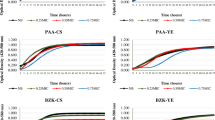Abstract
Antimicrobial activity of 19 commercially manufactured disinfectant substances on aSalmonella enteritidis strain was determined. The substances represented 8 quaternary ammonium salts (QAS) and 10 QAS combined with other additives. The antimicrobial efficacy was characterized by influencing the growth of bacterial cells expressed as MIC and ED50 values as well as by the inhibition of the incorporation rate of14C-adenine and14C-leucine. According to their efficacy the disinfectants were divided into three groups: (1) substances with strong inhibitory effect (MIC 6–45 µg/L) such as Diesin forte, Hexaquart plus, Neoquat S, Triquart, Almyrol, Hexaquart S, ID212, ID213 and Microbac forte; (2) substances with good antibacterial efficacy (MIC 90–780 µg/L); (3) substances with MIC values >780 µg/L (up to 3120 gmg/L). Cetrimide had very low activity (MIC 3.12–6.25 mg/L). The effect of disinfectants on the biosynthetic processes was expressed byR values (IC50(Ade) : IC50(Leu)); all these values were <1 except Benzalkonium chloride, FD312, Divoquat forte, 5P plus, Almyrol, Hexaquart S and Hexaquart plus. LowR values suggested interference of these substances with the synthesis of both nucleic acids and proteins. All substances except 5P plus caused an inhibition of endogenous respiration. The most effective were Almyrol, Diesin forte, Microbac forte and Neoquat which completely inhibited respiration at 190 mg/L. Kvart showed the lowest effect on the respiration over the whole concentration range. The disinfectants also suppressed growth ofS. enteritidis, probably by interfering with energy-yielding and-requiring processes in the cells.
Similar content being viewed by others
References
Adair F.W., Geftic S.G., Gelzer J.: Resistance ofPseudomonas to quaternary ammonium compounds.Appl.Microbiol.18, 299–302 (1969).
Altekruse S., Koehler J., Hickmen-Brenner F., Tauxe R.V., Ferris K.: A comparison ofSalmonella enteritidis phage types from egg-associated outbreaks and implicated laying flocks.Epidemiol.Infectol.110, 17–22 (1993).
Asheg A.A., Fedorova V., Pistl J., Levkut M., Revajová V., Kolodzieyski L., Ševčiková Z., Pilipčinec E.: Effect of low and high doses ofSalmonella enteritidis PT4 on experimentally infected chicks.Folia Microbiol.46, 459–462 (2001).
Balgavý P., Devínsky F.: Cut-off effects in biological activities of surfactants.Adv.Colloid.Interface Sci.66, 23–63 (1966).
Davison S., Benson C.E., Eckroade R.J.: Evaluation of disinfectants againstSalmonella enteritidis.Avian Dis.40, 272–277 (1996).
Devínsky F., Lacko I., Mlynarčík D., Račanský V., Krasnec L.: Relationship between critical micelle concentrations and minimum inhibitory concentrations for some non-aromatic quaternary ammonium salts and amine oxides.Tenside Detergents22, 10–15 (1985).
Hugo W.B.: Survival of microbes exposed to chemical stress.Proc. 26th Internat. Symp. Soc. General Microbiological Principles. University Press Cambridge, Cambridge 1976.
Jones M.V., Herd T.M., Christie H.J.: Resistance ofPseudomonas aeruginosa to amphoteric and quaternary ammonium biocides.Microbios518, 49–61 (1986).
Kopecká-Leitmanová A., Devínsky F. Lacko I., Mlynarčík D.: Interaction of amine oxides and quaternary ammonium salts with membrane and membrane-associated processes inE. coli cells: mode of action.Drug Metab.Drug Interact.7, 29–51 (1989).
Ling J.M., Koo I.C., Kam K.M., Cheng A.F.: Antimicrobial susceptibilities and molecular epidemiology ofSalmonella enterica serotype Enteritidis strains isolated in Hong Kong from 1986–1996.J.Clin.Microbiol.36, 1693–1699 (1998).
Lowbury E.J.L.: Prophylaxis and treatment for infection of burns.Brit.J.Hosp.Med.15, 566–577 (1976).
Lukinmaa S., Schildt R., Rinttilä T., Shtonen A.:Salmonella enteritidis phage types 1 and 4: pheno- and genotypic epidemiology of recent outbreaks in Finland.J.Clin.Microbiol.37, 2176–2182 (1999).
Majtán V.: Antibacterial activity of new desinfectans, (in Slovak) pp. 129–131 inProc. 13th Pečenka Days Epidemiol., Vsetín (Czechina) 1995.
Majtán V., Drobnica L’.: Effect of 2,3-dinitrilo-1,4-dithia-9,10-anthraquinone onMycobacterium smegmatis.Folia Microbiol.25, 403–412 (1980).
Majtán V., Drobnica L’.: Inhibition of the incorporation of14C-precursors inMycobacterium smegmatis by antibiotics and chemotherapeutics.Folia Microbiol.27, 43–48 (1982).
Majtán V., Majtánová L’.: Effect of organic ammonium salts on metabolic processes inPseudomonas aeruginosa.Pharmazie51, 54–56 (1996).
Majtán V., Majtánová L’.: Antibacterial efficacy of new commercially manufactured disinfectant substances againstSalmonella typhimurium.J.Basic Microbiol.37, 41–44 (1997).
Majtán V., Majtánová L’.: The effect of new disinfectant substances on the metabolism ofEnterobacter cloacae.Internat.J.Antimicrob.Agents11, 59–64 (1999).
Miko M., Drobnica L’., Chance B.: Inhibition of energy metabolism in Ehrlich ascites cells treated with dactylarinin vitro.Cancer Res.39, 4242–4251 (1979).
Olsen S.J., MacKinnon L.C., Goulding J.S., Bean N.H., Slutsker L.: Surveillance for food-borne-disease outbreaks — United States 1993–1997.Morb.Mortal.Week.Rep.49, 1–62 (2000).
Orsi G.B., Tomao P., Visca P.:In vitro activity of commercially manufactured disinfectants againstPseudomonas aeruginosa.Eur. J.Epidemiol.11, 453–457 (1995).
Rampling A., Anderson J.R., Upson R., Peters E., Ward L.R., Rowe B.:Salmonella enteritidis phage type 4 infection of broiler chickens: a hazard to public health.Lancet-ii8660, 436–438 (1989).
Reybrouck G.: Unification of the testing of disinfectants in Europe.Zbl.Bakt.Parasit.Infektion.Hyg.Abt.Orig.B182, 485–598 (1986).
Rodrigue D.C., Tauxe R.V., Rowe B.: International increase inSalmonella enteritidis: a new pandemic?Epidemiol.Infectol.105, 21–27 (1990).
Staples S.J., Asher S.E., Giannella R.A.: Purification and characterization of heat-stable enterotoxin produced by a strainEscherichio coli pathogenic for man.J.Biol.Chem.225, 4716–4721 (1980).
Telzak E.E., Budnick L.D., Greenberg M.S.Z., Blum S., Shayegani M., Benson C.E., Shultz S.: A nosocomial outbreak ofSalmonella enteritidis infection due to the consumption of raw eggs.New Engl.J.Med.323, 394–397 (1990).
Weiz S.C., Lee H., Trevors J.T.: Survival of free and alginate-encapsulatedPseudomonas aeruginosa UG2Lr in soil treated with disinfectants.J.Appl.Bacteriol.80, 19–25 (1996).
Author information
Authors and Affiliations
Rights and permissions
About this article
Cite this article
Majtán, V., Majtánová, L. Effect of disinfectants on the metabolism ofSalmonella enterica serovar enteritidis. Folia Microbiol 48, 643–648 (2003). https://doi.org/10.1007/BF02993472
Received:
Issue Date:
DOI: https://doi.org/10.1007/BF02993472




